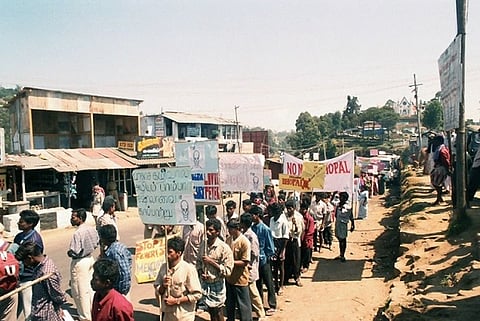

Christmas is a quiet time in Kodaikanal. Most tourists avoid travelling to the hill station in late December because the temperature goes down to around 8°C or even lower. For most south Indians, that is unbearably cold. The sun sets early, and there is a chill in the air. The streets are usually deserted, with very few people visible on the walkways and around the lake after sunset. But it is a good time for the residents, who are able to enjoy the charming Kodaikanal winter. With their fireplaces lit and hot filter coffee brewing, Kodaikanal residents like to enjoy this time of peace and quiet at home and catch up on pending household chores. It was no different for Mody.
Around Christmas in 2000, Mody was looking to procure some cast-off furniture for his humble cottage. During one of his evening walks, someone mentioned a used-goods shop three kilometres down in Moonjikkal.
The next evening, Mody walked down to Moonjikkal to the scrap dealer’s shop-cum-warehouse. While browsing through the decrepit furniture and old newspapers strewn around, his eyes landed on a sack of broken glass material. On closer inspection, he noticed that on the surface of the glass pieces were droplets of a liquid substance.
He spent a while quietly with this heap of glass pieces. It wasn’t something he could easily identify. Upon further scrutiny, he realized these pieces were of broken thermometers and he could make out that the droplets on them were the poisonous liquid metal mercury. Drops of mercury were trickling out of the sacks and onto the shop floor. When the shop owner acted evasively upon being asked about the origin of the glass scrap, Mody told himself they must be from a local clinic or hospital.
Walking back home pensively, Mody wondered how a hospital or clinic could have disposed of such a large quantity of broken thermometers. But where else could it have come from?
The next day, he instructed one of his PHCC assistants to visit the scrap dealer’s shop and assess the quantity of the glass thermometer waste without arousing any suspicion. While discreetly inspecting the store, the assistant realized there was an extension at its rear in the form of a large, thatched shed.
Once inside the shed, the assistant was thunderstruck. There were ‘tonnes and tonnes of mercury-laden glass waste’, as he would describe to Mody later in the day. Making a quick, rough assessment of the nature and quantity of the waste, he could tell it had been lying there for a long while, as more and more glass scraps were dumped over it.
Mody visited the place again subsequently and tried to engage the shop owner in a friendly conversation as he searched for answers to the multitude of questions swirling in his mind. Who had sold the waste to him? When did he first pick it up? Why was it lying there? How much had he paid for the waste per kilogram? What was its use? Where was it going from here? Were people handling it with bare hands? And so on.
He took it upon himself to investigate. Discreet enquiries revealed a shocking truth. The waste had come from the Pond’s factory, by now known as the Hindustan Lever Limited (HLL) company, on St Mary’s Road, yards away from his cottage. In his conversation with the shop owner, Mody had found that the man had no answers to most of the questions; rather he refused to reveal too much information.
By now a picture was emerging in Mody’s mind. The company seemed to have been irresponsibly disposing of the glass waste from its factory, probably for the last sixteen years. They were doing it through scrap dealers and by dumping in remote, isolated corners – maybe in the forests, maybe in the stream, perhaps even in the lake.
This is bad, this is really bad, he thought to himself.
His immediate thoughts were about how to handle the situation. There was a strong possibility the mercury waste lying with the scrap dealer could be taken back by the company and destroyed completely without leaving any trail of evidence. He felt a greater responsibility to inform the public in Kodaikanal and beyond about this ticking time bomb without any delay.

Excerpted with permission from the book 'Heavy Metal: How a Global Corporation Poisoned Kodaikanal' by Ameer Shahul. The book has been published by Pan Macmillan.